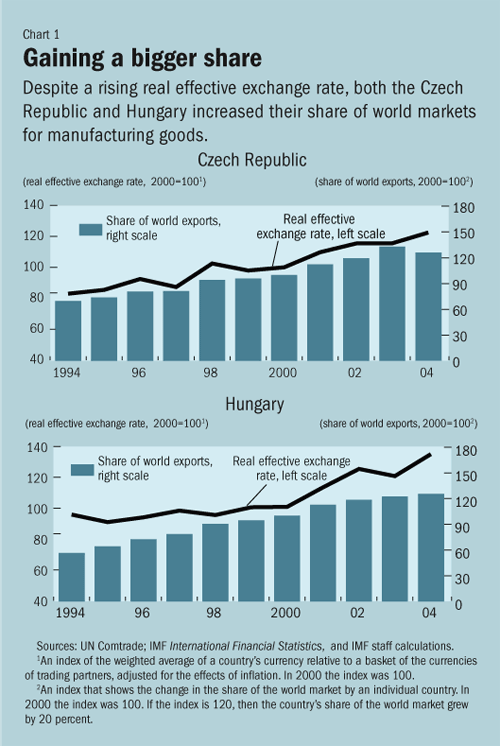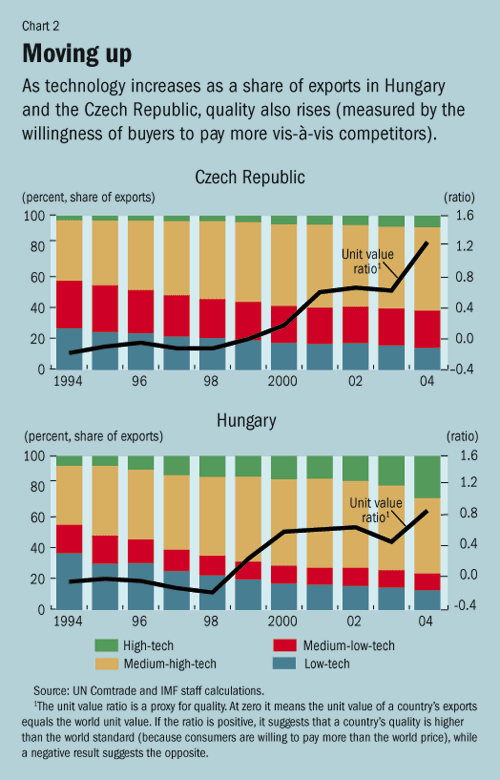
Typical street scene in Santa Ana, El Salvador. (Photo: iStock)
IMF Survey: Staying on Top of the Game
June 13, 2007
- EU's new members have stayed competitive by improving export quality
- Export enhancements boosted market share despite rising real exchange rates
- Catch-up period may be ending, making it harder to stay competitive
In the decade before they joined the European Union in 2004, most of the eight central and eastern European countries—collectively known as the CEE-8—were able to defy gravity, so to speak.

Brewery in Ceske Budejovice, Czech Republic, where transition to market economy was part of transformation study (photo: Sean Gallup/Getty Images)
CENTRAL AND EASTERN EUROPE
These countries overcame the weight of significantly appreciating exchange rates to achieve impressive export growth.
How did they overcome the drag of rising real exchange rates, which make exports more expensive relative to those of competitors, and significantly expand their share of world markets? (See Chart 1). A new IMF Working Paper, "The Dynamics of Product Quality and International Competitiveness" by Stefania Fabrizio, Deniz Igan, and Ashoka Mody, examines the export performance of the Czech Republic, Estonia, Hungary, Latvia, Lithuania, Poland, the Slovak Republic and Slovenia.

The authors find that the answer lies in the significant improvements most of these countries made in the quality and technological level of their exports (see Chart 2). The writers question, however, whether the countries will be able to continue these gains.

Structural transformation
The shift in the quality and technological intensity of exports that led to their increased market share was associated with structural transformations in the economies of the CEE-8 The transition from centrally planned to market-oriented economies, which occurred in the aftermath of the breakup of the Soviet Union, was accompanied by extensive privatization and restructuring as well as the dismantling of trade barriers and the inflow of foreign direct investment.
Forced to compete with international producers, in both domestic and foreign markets, firms in the CEE-8 survived by reducing their prices, adjusted for quality. To do so required both cost reduction and quality enhancement. The authors compared the prices of thousands of individual products—from wires to computers—in the CEE-8 countries and their competitors.
Trying to measure quality increases
It is very difficult to measure changes in the quality of a country's exports. The authors used a relatively new concept called the "unit value ratio" (UVR) as a proxy. The ratio is rooted in the idea that consumers will be willing to pay more for a product if they believe it is of a higher quality than the same product provided by a competitor.
The authors calculated a unit value for each export product by dividing the total export value by the volume. (for example, if the export value of batteries was $1 million and the country exported 500,000 batteries, the unit value would be 2) and then did the same for all competing exports. The authors then calculated the UVRs for all products by dividing their unit values by the unit values of the same products produced by other countries. Finally, the authors calculate an aggregate (weighted average) UVR from these product UVRs, using the weights of each product in the overall exports of the country, and perform statistical analysis on the ratio.
Although the statistical processes can be complicated, the bottom line is that if the ratio is positive, it suggests that a country's quality is higher than the world standard (because consumers are willing to pay more than the world price) while a negative result suggests the opposite.
The evidence shows an impressive shift in product quality—measured by the unit value of a country's exports relative to the unit value of world exports— and in the technological intensity of exports. At the same time, while the pace and timing of the shift varied across countries—with Latvia and Lithuania lagging—there was a movement from principally exporting relatively low-technology products to the medium-technology range and, more slowly, to the production and export of high-technology products.
Increased market share
The authors show that, in a cross-section of 58 countries during 1994-2004, quality and technology upgrading were associated with increased market share. The analysis demonstrates that the CEE-8 countries benefited from a catch-up process. Though their export shares were not small even in 1994, there was room for expansion, given that these are, with perhaps the exception of Poland, small, open economies.
Trade liberalization created the opportunities for expanded trade, and the economic reforms encouraged privatization, restructuring, and the expanded use of foreign capital and management skills. These developments allowed a process of quality and technology upgrading.
The authors show that such upgrading is consistent with gains in international market share. Furthermore, while quality and technology tend to improve together, the primary factor in gaining market share may well be quality improvements. This matches the finding that quality improvements in differentiated products—those that do not have well-defined standards and have the largest potential for quality variation—help not only the exports of differentiated products but also "spill over" to benefit reference-priced goods—those for which there are public standards and whose prices are available in specialized publications.
Country reputation
In other words, quality improvements appear related to building country reputation. Reputation building, in turn, is valuable when a country is not well established in international markets and information about its export quality and delivery capabilities has still to be fully established.
Looking ahead, the task facing the CEE-8 becomes challenging for several reasons. First, the catch-up period seems to be over, further gains in market share will be more difficult. Second, there is some evidence of decreasing returns to improved quality. Thus, with reduced prospects of catching up, and continued (and possibly heightened) technological competition, the pressure to maintain market shares will increase. Continued policy efforts to raise productivity will be needed.







